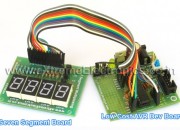High Power Multiplexed Seven Segment LED Display Driver
One of the most common place where small MCUs are used is to drive big seven segment displays in public area. For example the bank token number, flight or train schedule, train coach number, production volume (in factories), current forex(in banks) or gold rates etc. Since these are public display they should be big (and bright) enough to be seen from a distance of few meters. And due to their bigger size(and high brightness) they require 12V supply for each segments. Current requirement is also high. All these call for a sophisticated circuit, since these type of circuit is very common we have developed a compact board with integrated high voltage driver circuit coupled with an AVR 8 bit CPU. High Voltage Seven Segment Display Driver Board Further information, datasheet and user manual will be available as soon as the product is offered for sale. More Images

